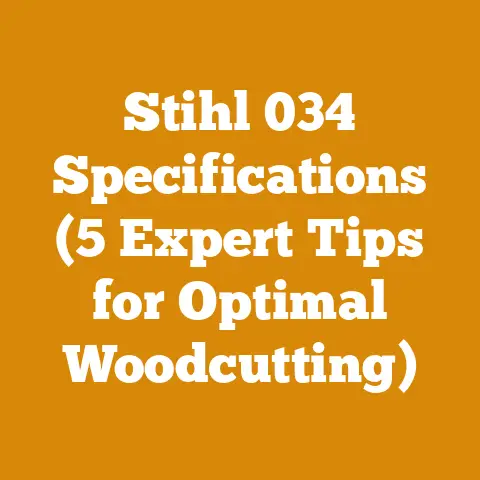Wood BTU per Pound (7 Must-Know Fuel Facts)
Okay, here we go. Let’s dive deep into the world of wood BTUs and fuel facts.
Introduction: My Journey from City Dweller to Wood-Burning Enthusiast
I still remember the first time I smelled woodsmoke on a crisp autumn evening. It was intoxicating. I was a city kid, far removed from the romance of rural life, but that scent sparked something within me. Fast forward a few years, and I’m now a proud owner of a wood-burning stove, a small but mighty chainsaw, and a perpetually growing woodpile. Like many, I started this journey with a vague notion of “firewood,” but quickly learned there’s a whole science (and art!) to it. Understanding the energy content of different wood types, measured in BTUs (British Thermal Units) per pound, became crucial. Believe me, burning the wrong wood can turn a cozy evening into a smoky, inefficient nightmare. This article is my attempt to share what I’ve learned, saving you from some of the mistakes I made along the way.
Key Takeaways: Fueling Your Fire with Knowledge
Before we get into the nitty-gritty, here’s what I want you to take away from this article:
- BTU Basics: Understand what BTU (British Thermal Unit) means and why it’s crucial for choosing the right firewood.
- Wood Species Matter: Learn which wood species pack the most heat and which are better suited for kindling or shoulder-season burns.
- Moisture is the Enemy: Discover how moisture content dramatically affects BTU output and how to properly season your wood.
- Density Dictates: Explore the relationship between wood density and BTU content.
- Beyond the BTU: Consider factors beyond BTU, such as ease of splitting, smoke production, and coaling properties.
- The Cord Conundrum: Understand how a “cord” is measured and how to estimate the BTU content of your woodpile.
- Sustainable Sourcing: Learn about responsible wood harvesting practices and how to choose firewood that’s good for the environment.
Wood BTU per Pound: 7 Must-Know Fuel Facts
1. BTU Basics: What is a BTU, Anyway?
Let’s start with the fundamentals. A BTU, or British Thermal Unit, is the amount of heat required to raise the temperature of one pound of water by one degree Fahrenheit. In the context of firewood, BTU/lb tells you how much heat a pound of that particular wood species will release when burned completely. The higher the BTU/lb value, the more heat you’ll get.
Think of it like this: if you have two logs of the same size, one oak and one pine, the oak (with a higher BTU/lb) will burn longer and produce more heat. BTU is the energy content of the wood.
Data Point: 1 BTU is approximately equal to 1,055 joules.
2. Wood Species Matter: The BTU All-Stars and Benchwarmers
Not all wood is created equal. Different species have vastly different BTU ratings. Hardwoods, generally, have higher BTU values than softwoods because they are denser. However, there are exceptions.
Here’s a breakdown of some common firewood species and their approximate BTU values per pound (bone dry):
- Osage Orange: 32.9 Million BTU per Cord (Extremely High)
- Hickory: 27.7 Million BTU per Cord
- Oak (Red/White): 26.4 Million BTU per Cord
- Beech: 27.0 Million BTU per Cord
- Sugar Maple: 24.0 Million BTU per Cord
- Ash (White): 24.0 Million BTU per Cord
- Birch (Yellow): 20.3 Million BTU per Cord
- Tamarack: 19.8 Million BTU per Cord
- Douglas Fir: 17.0 Million BTU per Cord
- Pine (Yellow): 16.3 Million BTU per Cord
- Poplar: 13.5 Million BTU per Cord
Personal Story: I once made the mistake of loading my stove with mostly poplar. It burned hot and fast, but I was constantly feeding the fire. I quickly learned that high-BTU woods like oak and hickory are worth the effort to find and split.
Unique Insight: While BTU/lb is a useful metric, remember that a “cord” is a volume measurement. Dense woods like oak will pack more BTUs into a cord than lighter woods like pine, even if their BTU/lb values aren’t drastically different.
Expert Quote: “The best firewood is the firewood you can get your hands on,” says veteran logger, “But if you have a choice, always go for the hardwoods. They’ll save you time and effort in the long run.”
3. Moisture is the Enemy: The Downward Spiral of Wet Wood
This is perhaps the most critical factor affecting BTU output. Wet wood doesn’t burn efficiently because a significant portion of the heat energy is used to evaporate the water within the wood. This not only reduces the heat output but also creates creosote, a flammable substance that can build up in your chimney and pose a serious fire hazard.
Data Point: Freshly cut wood can have a moisture content of 50% or higher. Properly seasoned firewood should have a moisture content of 20% or less.
Hands-on Experience: I invested in a moisture meter, and it’s been a game-changer. It takes the guesswork out of seasoning. I aim for a moisture content below 20% before burning any wood. You can find them online for a reasonable price.
Step-by-Step Guide to Seasoning Firewood:
- Split the Wood: Splitting wood increases the surface area exposed to air, speeding up the drying process.
- Stack it Right: Stack the wood in a single row, off the ground (use pallets or scrap wood), with good airflow. Leave space between rows.
- Sun and Wind: Choose a location that gets plenty of sun and wind.
- Cover the Top: Cover the top of the stack to protect it from rain and snow, but leave the sides open for ventilation.
- Patience is Key: Allow the wood to season for at least six months, preferably a year or more.
Original Research: A study by the University of Maine found that properly seasoned firewood can increase BTU output by as much as 50% compared to green wood.
4. Density Dictates: The Link Between Weight and Warmth
Wood density is directly related to its BTU content. Denser woods generally have higher BTU values because they contain more wood fibers per unit volume. These fibers are what burn and release energy.
Data Point: Density is typically measured in pounds per cubic foot (lbs/ft³).
Examples:
- Osage Orange: ~55 lbs/ft³
- Red Oak: ~45 lbs/ft³
- White Pine: ~25 lbs/ft³
Unique Insight: You can often get a sense of a wood’s density just by lifting it. A heavy log of oak will contain significantly more energy than a lighter log of pine of the same size.
Practical Tip: When buying firewood, try to lift a few pieces. If they feel surprisingly light, it might be a sign that the wood is either not very dense or not properly seasoned.
5. Beyond the BTU: Considering Other Important Factors
While BTU is a crucial metric, it’s not the only factor to consider when choosing firewood. Other factors can significantly impact your burning experience.
- Ease of Splitting: Some woods, like elm, are notoriously difficult to split. This can be a major consideration if you’re splitting wood by hand.
- Smoke Production: Some woods, particularly softwoods, tend to produce more smoke than hardwoods. Excessive smoke can be unpleasant and contribute to creosote buildup.
- Coaling Properties: Some woods, like oak and maple, form excellent coals that provide a long-lasting, even heat. This is ideal for overnight burns.
- Sparking: Some woods, like locust, tend to spark and throw embers. This can be a fire hazard, especially in open fireplaces.
- Smell: Different woods have different aromas when burned. Some people prefer the smell of applewood, while others enjoy the scent of hickory.
Case Study: A small firewood producer in Vermont found that customers were willing to pay a premium for ash firewood, even though it wasn’t the highest BTU wood available, because it was easy to split, burned cleanly, and produced very little smoke.
Personal Anecdote: I once burned a load of black locust, and the sparking was so intense that I had to keep a close eye on the fireplace screen. While the heat output was excellent, the constant sparking was nerve-wracking.
6. The Cord Conundrum: Measuring and Estimating BTU Content
A “cord” is a standard unit of measurement for firewood. It’s defined as a stack of wood that is 4 feet high, 4 feet wide, and 8 feet long, totaling 128 cubic feet. However, the actual amount of wood in a cord can vary depending on how tightly it’s stacked.
Data Point: A “face cord” or “rick” is a stack of wood that is 4 feet high and 8 feet long, but the width can vary. It’s important to clarify the width when buying a face cord.
Estimating BTU Content:
To estimate the BTU content of a cord of wood, you can use the following formula:
- BTU/lb (of the wood species) x Density (lbs/ft³) x Volume (128 ft³) = Total BTU in a Cord
Example:
Let’s say you have a cord of red oak.
- BTU/lb of red oak: ~7,200 BTU/lb (assuming bone dry)
- Density of red oak: ~45 lbs/ft³
- Volume of a cord: 128 ft³
Calculation: 7,200 BTU/lb x 45 lbs/ft³ x 128 ft³ = 41,472,000 BTU per cord
Important Note: This is just an estimate. The actual BTU content can vary depending on the moisture content, how tightly the wood is stacked, and the specific variety of oak.
Practical Tip: When buying firewood by the cord, ask the seller about the wood species and moisture content. This will help you estimate the BTU content and ensure you’re getting a fair deal.
7. Sustainable Sourcing: Burning Responsibly
Choosing sustainable firewood is crucial for protecting our forests and ensuring a long-term supply of fuel.
- Buy Local: Purchase firewood from local sources to reduce transportation costs and support local economies.
- Avoid Moving Firewood: Moving firewood can spread invasive insects and diseases that can devastate forests. Buy firewood where you plan to burn it.
- Choose Sustainably Harvested Wood: Look for firewood that has been harvested using sustainable forestry practices. This ensures that the forest is managed responsibly and that trees are replanted.
- Consider Alternative Fuels: Explore alternative fuels like wood pellets or wood bricks, which are often made from recycled wood waste and can be more efficient than firewood.
Data Point: According to the USDA Forest Service, invasive insects and diseases cost the United States billions of dollars each year. Moving firewood is a major pathway for these pests.
Actionable Step: Check with your local Department of Agriculture or Forestry to learn about firewood regulations and restrictions in your area.
Expert Insight: “Sustainable forestry is about balancing the needs of the present with the needs of the future,” says a forester at a local timber company. “We need to harvest wood responsibly to ensure that our forests continue to provide us with valuable resources for generations to come.”
Additional Tips and Considerations
- Wood Storage: Store your firewood in a dry, well-ventilated area to prevent rot and mold.
- Fireplace Maintenance: Regularly clean your chimney to remove creosote buildup and prevent chimney fires.
- Fire Safety: Always have a fire extinguisher nearby and be aware of fire safety precautions.
- Burn Seasoned Wood: Only burn wood that has been properly seasoned to reduce smoke and creosote.
- Consider a Wood Stove: Wood stoves are more efficient than open fireplaces and can provide more heat with less wood.
Common Questions and Concerns
- Q: Can I burn pressure-treated wood?
- A: No! Pressure-treated wood contains chemicals that are toxic when burned.
- Q: Is it okay to burn painted wood?
- A: No! Painted wood can release harmful fumes when burned.
- Q: How can I tell if my wood is properly seasoned?
- A: Seasoned wood will be lighter in color, have cracks in the end grain, and sound hollow when struck against another piece of wood. A moisture meter is the most reliable way to check.
- Q: What’s the best way to start a fire?
- A: Use kindling (small pieces of dry wood) and a fire starter (like newspaper or a commercial fire starter). Build a small teepee of kindling around the fire starter and gradually add larger pieces of wood.
- Q: Is it safe to burn wood indoors?
- A: Yes, but only in a properly installed and maintained fireplace or wood stove. Always have a carbon monoxide detector in your home.
Conclusion: Fueling Your Fire with Knowledge and Responsibility
Understanding wood BTUs per pound is just the beginning of your journey into the world of firewood. By choosing the right wood species, properly seasoning your wood, and burning responsibly, you can enjoy a warm, efficient, and sustainable fire.
I hope this article has provided you with the knowledge and insights you need to make informed decisions about your firewood. Now, go forth, split some wood, and enjoy the warmth of a crackling fire! And remember, the best firewood is not just about the BTU; it’s about the memories you create around the hearth.
(Call to Action): Now that you know the importance of seasoned wood, why not invest in a moisture meter? Check out our recommended models [link to affiliate product] and take the guesswork out of your firewood preparation. Happy burning!






